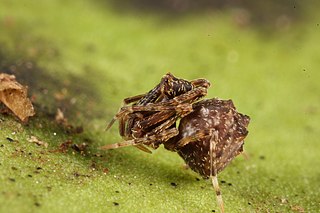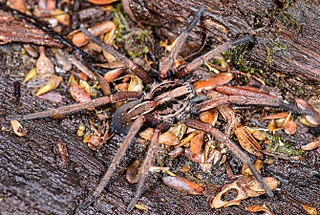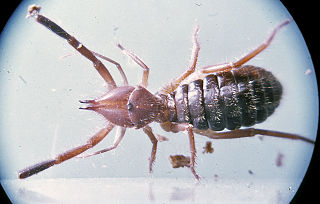
Wolf spiders are members of the family Lycosidae. They are robust and agile hunters with excellent eyesight. They live mostly in solitude, hunt alone, and usually do not spin webs. Some are opportunistic hunters, pouncing upon prey as they find it or chasing it over short distances; others wait for passing prey in or near the mouth of a burrow.

Avicularia is a genus of the family Theraphosidae containing various species of arboreal tarantulas. The genus is native to Panama, the Caribbean and tropical South America. Each species in the genus has very distinguishable pink foot pads.

Ludwig Carl Christian Koch was a German entomologist and arachnologist.

Archaeidae, also known as assassin spiders and pelican spiders, is a spider family with about ninety described species in five genera. It contains small spiders, ranging from 2 to 8 millimetres long, that prey exclusively on other spiders. They are unusual in that they have "necks", ranging from long and slender to short and fat. The name "pelican spider" refers to these elongated jaws and necks used to catch their prey. Living species of Archaeidae occur in South Africa, Madagascar and Australia, with the sister family Mecysmaucheniidae occurring in southern South America and New Zealand.

Cheiracanthium, commonly called yellow sac spiders, is a genus of araneomorph spiders in the family Cheiracanthiidae, and was first described by Carl Ludwig Koch in 1839. They are usually pale in colour, and have an abdomen that can range from yellow to beige. Both sexes range in size from 5 to 10 millimetres. They are unique among common house spiders because their tarsi do not point either outward, like members of Tegenaria, or inward, like members of Araneus), making them easier to identify. The name is a reference to the backwardly directed process on the cymbium of the male palp. The species epithet is derived from the Greek Ancient Greek: χείρ, romanized: cheir, meaning "hand", and Acanthium, a genus of thorny-stemmed plants.

Stanwellia is a genus of South Pacific mygalomorph spiders in the family Pycnothelidae. It was first described by W. J. Rainbow & R. H. Pulleine in 1918. Originally placed with the curtain-web spiders, it was transferred to the funnel-web trapdoor spiders in 1985, then to the Pycnothelidae in 2020. It is a senior synonym of Aparua.

Stanwellia grisea, also known as the Melbourne trapdoor spider, is a species of mygalomorph spider in the Pycnothelidae family. It is endemic to Australia. It was described in 1901 by British arachnologist Henry Roughton Hogg.

Corinna is a genus of corinnid sac spiders first described by Carl Ludwig Koch in 1841. They are found in Mexico and south to Brazil, and with selected species found in Africa.
Forsterina is a genus of South Pacific intertidal spiders that was first described by Pekka T. Lehtinen in 1967.

Miturga is a genus of spiders in the family Miturgidae. It was first described in 1870 by Thorell. As of 2017, it contains 17 species, all from Australia.

Floronia is a genus of spiders in the family Linyphiidae first described by Eugène Simon in 1887.

Pityohyphantes, commonly known as hammock spiders, is a genus of sheet weavers that was first described by Eugène Louis Simon in 1929. The name comes from the Ancient Greek Πίτυς (pitys), meaning "pine", and hyphantes, meaning "weaver".
Storena is a genus of ant spiders first described by Charles Athanase Walckenaer in 1805.

Gluvia is a monotypic genus of daesiid camel spiders, first described by Carl Ludwig Koch in 1842. Its single species, Gluvia dorsalis is one of the only species of solifugid found in Portugal and Spain. It is reported to be a common species on the streets of Madrid.
Stanwellia pexa is a species of mygalomorph spider in the Pycnothelidae family. It is endemic to Australia. It was described in 1930 by Australian arachnologist Vernon Victor Hickman.
Stanwellia nebulosa, also known as the nebular trapdoor spider, is a species of mygalomorph spider in the Pycnothelidae family. It is endemic to Australia. It was described in 1918 by Australian arachnologists William Joseph Rainbow and Robert Henry Pulleine.
Stanwellia occidentalis is a species of mygalomorph spider in the Pycnothelidae family. It is endemic to Australia. It was described in 1972 by Australian arachnologist Barbara York Main.
Stanwellia inornata is a species of mygalomorph spider in the Pycnothelidae family. It is endemic to Australia. It was described in 1972 by Australian arachnologist Barbara York Main.
Stanwellia minor is a species of mygalomorph spider in the Pycnothelidae family. It is endemic to Australia. It was described in 1908 by Polish arachnologist Władysław Kulczyński.










